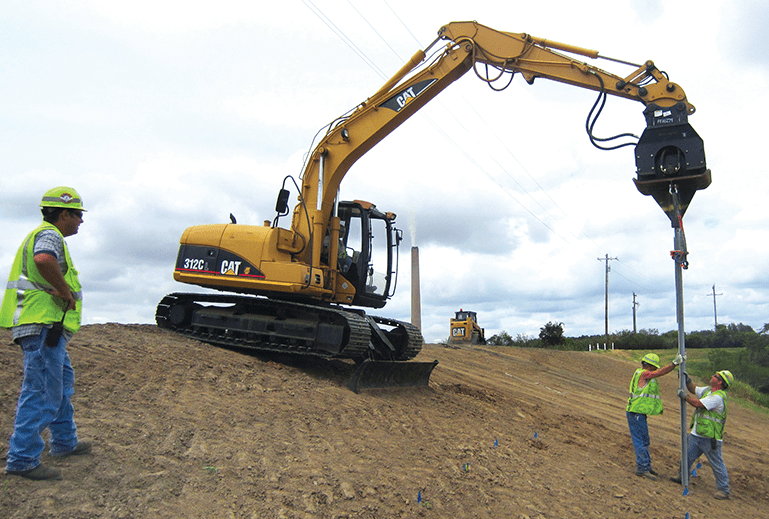
Construction projects often get a bad rap in terms of environmental and social impact in the vicinity of where they are happening. People outside the construction field usually get a vision in their mind as soon as they hear the work “construction” or “excavation” that brings about visions of huge dirty truckloads of soil being removed by dozens of trucks around the clock. Slope stabilization can refer to means and methods by which existing or new slopes are stabilized or steepened beyond what the natural or placed soil can manage on its own.
Some slope stability construction projects involve excavations where the cut is not deep enough to necessitate an expensive shoring system, but the slope is a little steeper than what is allowed by the geotechnical engineer (or by the slopes natural angle of repose). Other slope stability construction projects involve the need to construct a new embankment or slope to create grade separations (i.e. new overpass or rail embankment) that is on soils that are weaker and thereby the new load creates instabilities in the embankment or slope.
Still others involve existing slopes that are failing because of poor installation or change in conditions over time. Examples of changes in condition could be: additional surface or seepage water due to climate change; erosion creating instability; loss of vegetation; the addition of surcharge load; or the introduction of an excavation along or at the base of an existing slope.
Whatever the specifics, these projects often involve traditional options that are invasive and result in lots of moving dirt. For example, a failing slope is often scraped down for the purpose of rebuilding it with a more stable system. Let’s face it, in urban areas or locations with surrounding infrastructure or people, this type of construction can be very disruptive both socially and environmentally.
With that said, the way things are done in the construction field, as well as the way people are viewing the construction industry is rapidly changing, and thankfully for the better. A few of the more recent improvements include: green building awards, policies protecting watersheds and soil handling and disposal policies (excess soil management).
The days of companies wilfully scraping away soil, one of our most precious resources, from an unstable slope is also coming to an end. One system that has proven to be an environmentally viable, cost-efficient and rapid solution to stabilizing slopes and embankments is the Geopier Slope Reinforcement Technology® (SRT) system. Invented by a Dr. Dick Short while he was working as a geotechnical consultant, he was quoted as saying this as it related to traditional slope stability approaches:
“I was working as a geotechnical consultant in California and had a contract to correct 60 landslides for a conservation district. I was disturbed how the state of the practice for dealing with these slides was to either over excavate and replace the failure zone with stone or a geogrid reinforced fill… the former not always being effective and the latter being expensive and often not practical. There had to be a better way to stabilize the slides in place! So, I decided to come up with a way that was less expensive, quicker and better… and that was SRT Plate Piles.”
Typically, the Geopier SRT® system is installed by driving Plate Pile™ elements (vertical steel reinforcement elements) using small, tracked excavators with a hydraulic hammer or vibratory hammer that can be quickly installed into a competent layer of soil. This system is ideally suited to stabilize slopes where the soil conditions consist of an upper shallow zone of weathered, loose, soft or disturbed soil over a stronger layer of soil below.
Patented Plate Pile™ technology provides slope stabilization using a collection of rigid steel piles that are driven vertically, or near vertically, into the affected slope in a staggered arrangement of equally spaced rows so that the soil upslope of the pile can fully bear on the pile through soil arching. Plate Pile technology increases the stability of shallow landslides by installing rigid elements that incrementally reinforce the soil embankment. Each Plate Pile engages a prism of slope soil and transfers the load through the rigid element to the stable soil mass below to which it is affixed to at its base for resistance through bending. Additionally, the system does not require a hard face like soil nails and can easily be naturalized following installation.
Furthermore, Plate Piles are extremely effective in stabilizing landslides of varying degrees up to 1H:1V and slide depths up to 3.6 metres (12 feet). The SRT system is excellent for use on sites that have complex equipment access issues or areas that require minimal environmental disturbance. By utilizing the SRT system, time-consuming and expensive earth moving and excavation can be completely avoided. In addition, the SRT system is minimally invasive to the environment and is considered to be the cleanest and fastest method for creating true and permanent slope stability.
Mark Tigchelaar, P. Eng. is president of GeoSolv Design/Build Inc. For more information regarding the SRT system and other innovative ground improvement methods, contact GeoSolv Design/Build Inc. at solutions@geosolv.ca.